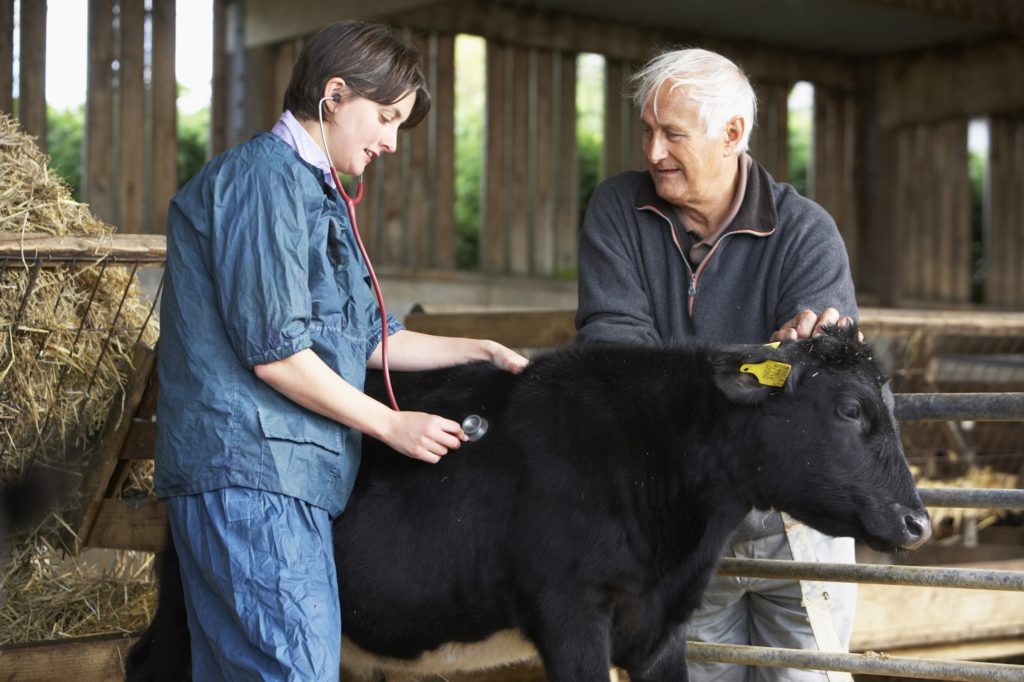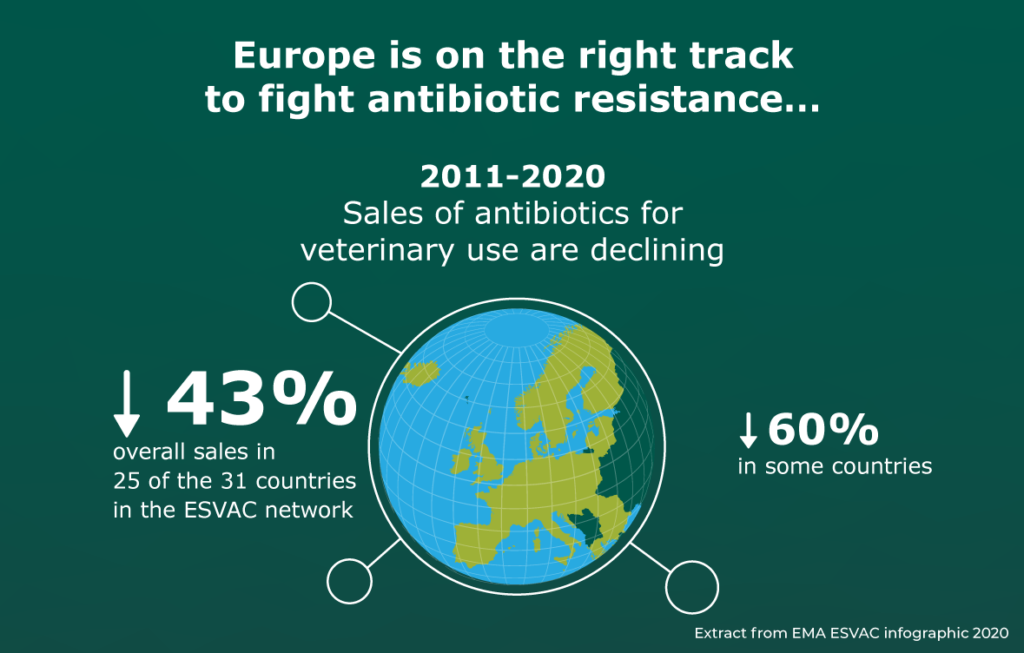European livestock farming shouldering its responsibility to keep antibiotics working

European farmers and veterinarians are making great efforts to reduce the need to use antibiotics. They have been very successful so far. The livestock sector has made great strides to limit the use of antibiotics and make a valuable contribution to ensuring the responsible use of antibiotics. But further efforts are needed from all sectors to ensure a “One Health” response to addressing antimicrobial resistance (AMR). Any restrictions to use of antibiotics for livestock in order to protect human health must remain science-based so as not to endanger animal health and welfare. According to ECDC 75% of AMR-related infections come from hospitals and health facilities. Clearly, even if we stopped all antibiotic use in animals, the impact on the human antimicrobial resistance problem would not be significant.
This is why calling for ever more restrictive policies on antibiotic use for animals is non-sensical, especially in the EU where 94% of Eurobarometer respondents say it’s important to protect the welfare of farmed animals.
Recently, the FVE (Federation of Veterinarians of Europe) took note of such calls in a report titled ‘Ending Routine farm antibiotic use in Europe’, published by the EPHA (European Public Health Alliance). This report spreads an unfounded assumption – some might say fake news – that farmers will not adopt the new rules on antibiotic use. The FVE reacted to this report, highlighting the many initiatives taken over the last 15 years for combatting the emergence of antibiotic resistance and the preservation of effective antibiotics for people and animals.
The target proposed in the EPHA report to set a maximum level of 30 mg/kg per population correction unit (PCU) to be later decreased to 15 mg/kg PCU is not only unscientific, it’s also unrealistic, as in every country, there are differences in the occurrence and spread of bacterial diseases, animal population, etc. Animals, when needed, deserve treatment, just like people. When they get sick, animals have the right to be treated in the best possible way to avoid unnecessary suffering. In this context, antibiotics remain the only solution for treating bacterial infections in animals, just as in people. And it should always be up to the veterinarian to decide the optimum way to administer medication, which remains under veterinary control and prescription.
It is necessary to use antibiotics more sparingly in all areas to address the rise in antimicrobial resistance. Still, this challenge requires coordinated, strategic and scientific action with a One Health approach. The EU regulation on veterinary medicines, approved more than two years ago by the European Parliament, takes strict measures to reduce the use of antibiotics to protect both animal and public health. This is promoted by the Commission to be an effective tool to help achieve the “Farm to Fork” strategy goal of reducing by 50% antibiotic sales by 2030.
The efforts made so far in the livestock sector in Europe are widely recognised and measurable. Animal health and welfare standards are higher in the EU than anywhere else in the world. The EU has stringent inspections on residues of veterinary medicines and contaminants in animal source food and an overall monitoring system, which show a compliance of the sector with all safety standards close to 100%. The veterinarian’s responsibility is to assess the farm animal’s health, diagnose, and prescribe the correct treatment, just as medical doctors do for people. Awareness in farmers and veterinarians of the damage caused by the abuse of antibiotics has been increasing over the past years. In 2005, the European Platform for the Responsible Use of Medicines in Animals – EPRUMA was created in synergy with veterinarians, farmers and the animal health industry. Since then, sales of veterinary antibiotics have fallen by more than 43%.

In fact the EMA’s recent ESVAC report showed an overall 43.2% drop in sales of veterinary antibiotics since 2011. And these efforts extend not only to the amounts of antibiotics used for animal health purposes but also to the classes of antibiotics used. The report shows a significant decrease in sales of veterinary antibiotics considered important from the medical point of view: 32.8% for third and fourth generation cephalosporins; 76.5% for polymyxins, 12.8% for fluoroquinolones and 85.4% for other quinolones.
That is why an even more stringent ban on antibiotics in animals than scientifically judged will have little effect on antibiotic resistance resolution. On the contrary, there is a high risk of a counterproductive effect. Dependence on a strictly limited number of antibiotics to treat animals’ infections will increase the pressure on bacteria, accelerating resistance to those few antibiotics available.
The new EU rules on veterinary medicines in force since January 2022 establish some new restrictions on the use of antibiotics. For example, all antibiotics for animals remain prescription-only throughout the EU, but the new rules are more explicit on prescriptions for preventive use. Preventive use remains prohibited, except for a single animal or a limited number of animals, in cases where the risk of infection is very high and the consequences are severe. The new current laws are also maintaining the ban on antibiotics to promote growth, in force since 2006.
Antibiotics may not be used on all the herd, but only to treat a limited group of animals, also when the group’s risk of spreading infectious disease is high, and no alternatives are available. The use of antibiotics should be limited to cover the risk of infection and only after the veterinarian’s diagnosis. A key initiative in the new law is the creation of a list of antibiotics reserved for human health, published on the basis of the EMA’s scientific advice. The new legislation also states that restrictions on antibiotics and the ban on the use of treatments classified as essential for human health will also apply to producers in third countries exporting animals or animal source foods to the EU.
To ensure further efforts to keep antibiotics working European veterinarians and farmers require support to maximise preventive approaches, such as vaccination, selective breeding, good nutrition, including the use of specialty feed ingredients to support animals’ defences against biological stressors for optimal health and higher resilience to stressors, environmental hygiene, biosecurity measures, monitoring for signs of infection and the use of diagnostic tools. It is also important in this context to explore the potential of new genomic techniques.
The best way forward is through recognising that the health of people, animals and the environment are closely connected and must be addressed collectively. But the “One Health” concept is often misunderstood, as this does not mean subordinating animal health to public health by only looking at how health challenges in animals will impact people.
The strong commitment of the livestock sector to improve the health and welfare of farm animals has led to the implementation of best practices, with significant progress in many European countries. Raising awareness and collaboration with stakeholders, monitoring antibiotics effectiveness, and the need to use them has achieved a marked reduction in antibiotic use in animals. The 2019 European Court of Auditors report on AMR recognised the progress already made in the animal sector, and the multi-stakeholder platform EPRUMA (European Platform for Responsible Use of Medicines in Animals) says the European livestock sector continues to work on further reducing the need for antibiotics. Only in this way can we strengthen the responsible use of antibiotics for animal health and play a part in addressing the challenge of antimicrobial resistance.